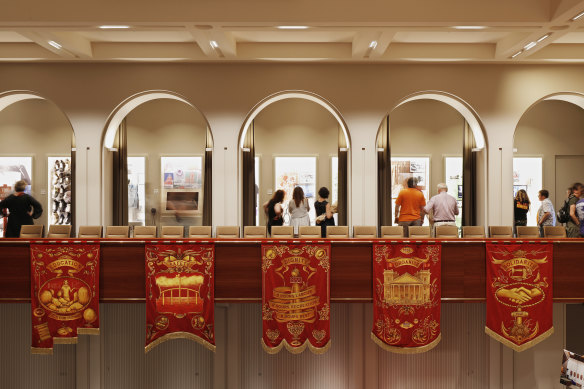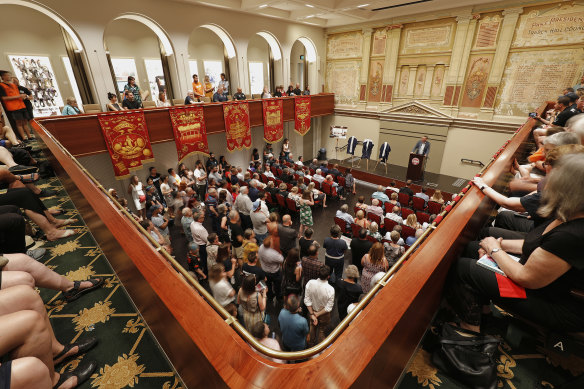This was published 3 years ago
Trades Hall’s heritage interior exquisitely restored
By Stephen Crafti
Trades Hall has been touched by some of the finest practitioners, such as the eminent architect Joseph Reed and the highly respected decorators, C.S. Paterson Brothers, responsible for the murals and decorative embellishments.
“It’s satisfying to know the trade union headquarters was seen as important as other significant Victorian buildings of that time,” says Liz Beattie, project liaison with Trades Hall, who followed the transformation of what’s now called Solidarity Hall and the old council chambers.

Trades Hall’s Solidarity Hall.Credit: Peter Glenane
Both rooms feature the work of the Paterson Brothers, whose frescos can be seen at Government House and at Villa Alba.
Designed by Reed in 1874 and completed in a series of stages until 1925, the grand Victorian pile, with its massive Corinthian columns, is an important landmark on the corner of Victoria Parade and Lygon Street.
While attention had to be given to the exterior in recent years, what was then the New Council Chamber displayed serious water damage, with the roof even collapsing.

Framed by new arches and new seating, the podium level is a blending of both new and old.Credit: Peter Glenane
This damage led to its refurbishment in the 1960s, with a chequerboard plywood ceiling dotted with similarly shaped lights.
“It was incongruous with the original design, covering the northern wall painted by the Paterson Brothers (of past presidents and decorative garlands from the 19th century).”
“It had also become far too large for council meetings,” says architect Stuart Hanafin, senior associate with Lovell Chen, recognised for its heritage work.
“This space also had to function for other purposes, whether it was for events or as part of the Melbourne international Comedy Festival,” he adds.
Recipient of an architecture award from the Australian Institute of Architects, what was previously a fairly tired hall now goes back to its roots.
Pivotal to the restoration is the Paterson Brothers’ mural, with the three eights decorated on one of the vases: eight hours for work, eight hours for recreation and eight hours for rest.
This motto is also featured in the emblems on the new customised carpet that wraps around the gallery on the first floor.
The glass cabinets, painted in gold Victorian script, are as succinct, with phrases such as “Equal pay for the sexes” and “Which side are you on?”
Although these words are still part of conversations today, some of the cabinets’ contents, such as one filled with shoes of all sizes, capture the memory of those who lost their lives in work accidents.
There’s even a worn denim jacket once owned by union leader John Cummins in the 1970s and ’80s.
Framed by new arches and new seating, the podium level is a blending of new and old.
“We certainly don’t mimic the past. It’s always important to reveal more contemporary additions,” says Hanafin.
While Solidarity Hall has a fine fusion of the past and present, the old council chamber from 1884 is like walking into a scene from a Victorian novel.
Completely water damaged, it has been exquisitely restored.
The lunettes over the doors by the Paterson Brothers have been cleaned and restored, as have the timber benches, which would be considered extremely uncomfortable to sit on by today’s standards.
Although the walls appear to be have been re-wallpapered with an appropriate design of the period, they have in fact been hand-painted with a glaze to create the feel of wallpaper.
“We worked closely with the conservators at the Grimwade Centre for Cultural Materials Conservation, who assisted us to create the right lustre for these walls,” says Hanafin.
Hanafin and Beattie have enjoyed the journey of seeing Trades Hall come back to life.
But they also enjoyed the dialogue that important architecture and design has in the context of time.
From the old council chambers, the western and only view is of architect Graeme Gunn’s 1970s brutalist building for the Plumbers and Gasfitters Union.
“It’s good to see that the legacy of using great architects through the decades continued well after Trades Hall was completed,” adds Beattie.